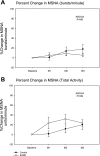Exercise pressor reflex in humans with end-stage renal disease
- PMID: 18685067
- PMCID: PMC2576092
- DOI: 10.1152/ajpregu.90473.2008
Exercise pressor reflex in humans with end-stage renal disease
Abstract
Previous work has suggested that end-stage renal disease (ESRD) patients may have an exaggerated sympathetic nervous system (SNS) response during exercise. We hypothesized that ESRD patients have an exaggerated blood pressure (BP) response during moderate static handgrip exercise (SHG 30%) and that the exaggerated BP response is mediated by SNS overactivation, characterized by augmented mechanoreceptor activation and blunted metaboreceptor control, as has been described in other chronic diseases. We measured hemodynamics and muscle sympathetic nerve activity (MSNA) in 13 ESRD and 16 controls during: 1) passive hand movement (PHM; mechanoreceptor isolation); 2) low-level rhythmic handgrip exercise (RHG 20%; central command and mechanoreceptor activation); 3) SHG 30%, followed by posthandgrip circulatory arrest (PHGCA; metaboreceptor activation); and 4) cold pressor test (CPT; nonexercise stimulus). ESRD patients had exaggerated increases in systolic BP during SHG 30%; however, the absolute and relative increase in MSNA was not augmented, excluding SNS overactivation as the cause of the exaggerated BP response. Increase in MSNA was not exaggerated during RHG 20% and PHM, demonstrating that mechanoreceptor activation is not heightened in ESRD. During PHGCA, MSNA remained elevated in controls but decreased rapidly to baseline levels in ESRD, indicative of markedly blunted metaboreceptor control of MSNA. MSNA response to CPT was virtually identical in ESRD and controls, excluding a generalized sympathetic hyporeactivity in ESRD. In conclusion, ESRD patients have an exaggerated increase in SBP during SHG 30% that is not mediated by overactivation of the SNS directed to muscle. SBP responses were also exaggerated during mechanoreceptor activation and metaboreceptor activation, but without concomitant augmentation in MSNA responses. Metaboreceptor control of MSNA was blunted in ESRD, but the overall ability to mount a SNS response was not impaired. Other mechanisms besides SNS overactivation, such as impaired vasodilatation, should be explored to explain the exaggerated exercise pressor reflex in ESRD.
Figures






References
-
- Adams GR, Vaziri ND. Skeletal muscle dysfunction in chronic renal failure: effects of exercise. Am J Physiol Renal Physiol 290: F753–F761, 2006. - PubMed
-
- Agarwal R, Nissenson AR, Batlle D, Coyne DW, Trout JR, Warnock DG. Prevalence, treatment, and control of hypertension in chronic hemodialysis patients in the United States. Am J Med 115: 291–297, 2003. - PubMed
-
- Batman BA, Hardy JC, Leuenberger UA, Smith ML, Yang QX, Sinoway LI. Sympathetic nerve activity during prolonged rhythmic forewarm exercise. J Appl Physiol 76: 1077–1081, 1994. - PubMed
-
- Blake JW, Solangi KB, Herman MV, Goodman AA, Meggs LG. Left ventricular response to exercise and autonomic control mechanisms in end-stage renal disease. Arch Intern Med 149: 433–436, 1989. - PubMed
-
- Campistol JM Uremic myopathy. Kidney Int 62: 1901–1913, 2002. - PubMed
Publication types
MeSH terms
Grants and funding
LinkOut - more resources
Full Text Sources
Medical

